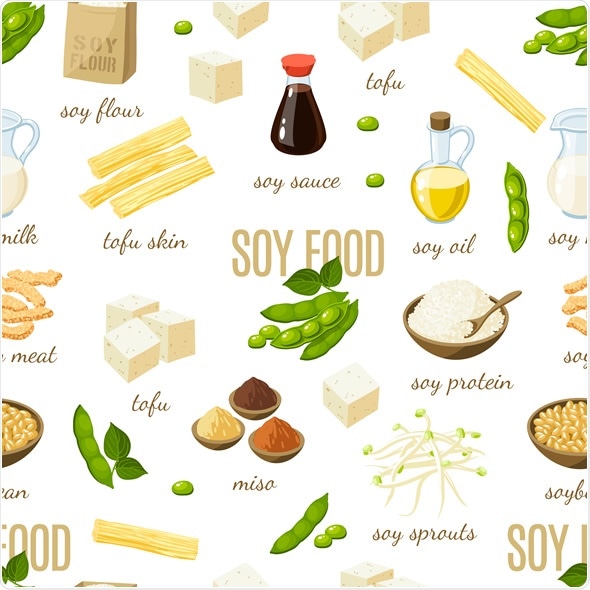Soy is a common ingredient contained in many processed foods and in infant formulas. Soy allergy generally occurs in early childhood, with most children growing out of the allergy by the age of ten.

Green soybean plants close-up, Image Copyright: oticki / Shutterstock
Cause
A soy allergy is caused by the immune system mistaking soy protein for a harmful substance, referred to as an allergen. This triggers the production of immunoglobulin E (IgE) antibodies, which then flag the soy protein up to the immune system the next time a person consumes it. Histamine and other chemicals are then released into the bloodstream, causing the signs and symptoms of allergy.
Signs and Symptoms
Soy allergy often begins when infants react to soy-based formulas, although it can develop at any age and be caused by foods that a person has previously eaten without experiencing any problems.
Usually, symptoms of the reaction are mild and may include:
- hives
- itching in the mouth area
- a congested or runny nose.
In rare cases, soy allergy can lead to a more severe reaction called anaphylaxis, which can be life threatening if not treated. During anaphylaxis, the throat swells up, there is a sharp fall in blood pressure and breathing becomes difficult. This condition requires immediate treatment with epinephrine, the only drug that can reverse these symptoms. Therefore, it is recommended that people with a soy allergy carry an epinephrine auto-injector on their person at all times.
Risk factors
Certain factors increase the likelihood that a person will develop a soy allergy and these include the following:
- A family history of allergies such as eczema, asthma or hay fever
- Age – this allergy is more common in children, particularly babies and infants
- Existing allergies – In some cases, people who already have an allergy to other foods are also allergic to soy
Diagnosis
If a doctor suspects a person has a soy allergy, they will ask questions about the symptoms and perform a physical assessment. They may also ask that the patient keeps a food diary that details any food items eaten and describes any symptoms that occur after eating.
In addition, they may recommend a skin prick test and/or a blood test. For the skin test, the skin is pricked and exposed to small amounts of soy protein. If a person is allergic, they will develop a raised bump or hive at the exposed site. A blood sample may also be taken to check the amount of immunoglobulin (IgE) antibodies a person has in their bloodstream.

Image Copyright: artzenter / Shutterstock
Management
To prevent a reaction to soy, it is essential to avoid consuming soy and soy products. People with a soy allergy should read the ingredients listed on any food products before buying or consuming them.
Soy and any of the following ingredients should be avoided:
- Soy, including soy cheese, soy flour, soy grits, soy milk, soy sprouts, soy albumin, soy fiber, soy nuts, soy yogurt and soy ice cream.
- Shoyu
- Edamame
- Miso
- Natto
- Soya
- Tamari
- Tempeh
- Tofu
- Soybean curd and soybean granules
- Soy protein
- Soy sauce
- Textured vegetable protein
- Soy may also sometimes be found in vegetable starch/broth/gum and in Asian cuisine.

Soy foods - soy milk, soy sauce, soy meat, tofu, miso. Image Copyright: mything / Shutterstock
If a person does accidentally consume soy proteins, antihistamines can be used to relieve symptoms and discomfort. Examples of antihistamines that are available over-the-counter include loratadine, cetirizine and diphenhydramine. If a person has a more severe reaction, they may require emergency treatment and an injection of epinephrine.
Further Reading
Last Updated: Dec 30, 2022